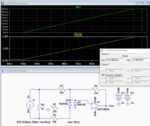Mozaaljh
Newbie level 4
We found this circuit in one of our transducer boards .. which converts the analog 4-20ma signal to some voltage for the ADC module of the microcontroller .. As the transducer is not working any more .. we are trying to fix it and are unaware of the output voltage of the opamp . We tried the superposition method but we are still unable to synthesise the circuit..
The image of the circuit attached

The image of the circuit attached

Last edited by a moderator:
